February 8, 2024
Grace Chrisman
SEOUser ExperienceWeb DesignWeb Development
Is Your Website Outdated? 8 Signs It’s Time for A Website Makeover
Think of your website like it’s a loaf of bread: the expiration date is more of a suggestion than a requirement. But also use your best judgment to toss it when it’s no longer serving your needs. A stiff and moldy sandwich? No thanks. Similarly, an outdated website design and poor user experience (UX) can contaminate the overall perception of your brand.
Web design trends and UX best practices are constantly shifting as search engines like Google update their algorithms to display the most relevant, useful content. If you don’t adapt to meet users’ expectations, they’ll stop visiting your site. A custom website redesign might be just what your business needs to stay fresh and relevant in the eyes of Google and your users.
How Often Should You Redesign Your Website?
Generally, every two to three years is the recommended best practice for businesses to refresh the look and feel of their site. This timeline allows businesses to touch up lackluster areas of their outdated website to be in sync with search engine algorithm updates and usage trends.
At Blue Compass, our custom website redesign services aim to extend the life of your business’ new look beyond the traditional timeframe. We approach websites that need a redesign with user experience and longevity in mind. It might be tempting to pursue a website makeover that transforms your site into the face of the latest and greatest web trend, but a fancy new look shouldn’t come at the expense of a user’s ability to access various items on your site.
By focusing on timeless design features and functionality, we position your website redesign to carry your brand forward for at least three to five years. That’s nearly double the industry standard. Considering your website is likely the first point of contact for many customers seeking your products and services online, you can’t afford to let your website fall behind in creating a smooth user experience.
Why You Need To Update Your Website’s Design
Websites in need of a redesign typically fail to provide a positive user experience or clear navigation structure to explore the site, detracting from your credibility as a business. They typically give off warning signs that a redesign is needed. Poorly structured websites prevent users from finding the information they need, leading to frustration and causing users to leave your site.
According to statistics aggregated by HubSpot in 2023, 42% of people reported leaving a website if it functioned poorly. When asked why users might leave a website, 73% of professional web designers cited non-responsive design as a major contributor, meaning sites that fail to adjust their layout based on device size are at a disadvantage compared to mobile-friendly designs.
Similarly, more than a third of users reportedly pay attention to a site's layout or navigation the first time they visit it, indicating users place high importance on being able to independently navigate your site. No matter how you look at it, the number of users scared away by cluttered content, disorganized menus or disorienting designs could be debilitating to your business and your ability to get leads online.
Signs Your Website Needs A Redesign
If your current website is already a couple years old but still working well for you, great! There’s no need to fix something that isn’t broken. But don’t hold on to an old web design solely for the sake of familiarity. Does your website do everything you want it to? Is your website traffic as high as you’d hoped? Are you struggling with low engagement or lack of conversions? Here’s a look at the problematic web design features that delay your business’ growth potential:
1. Slow Page Speed
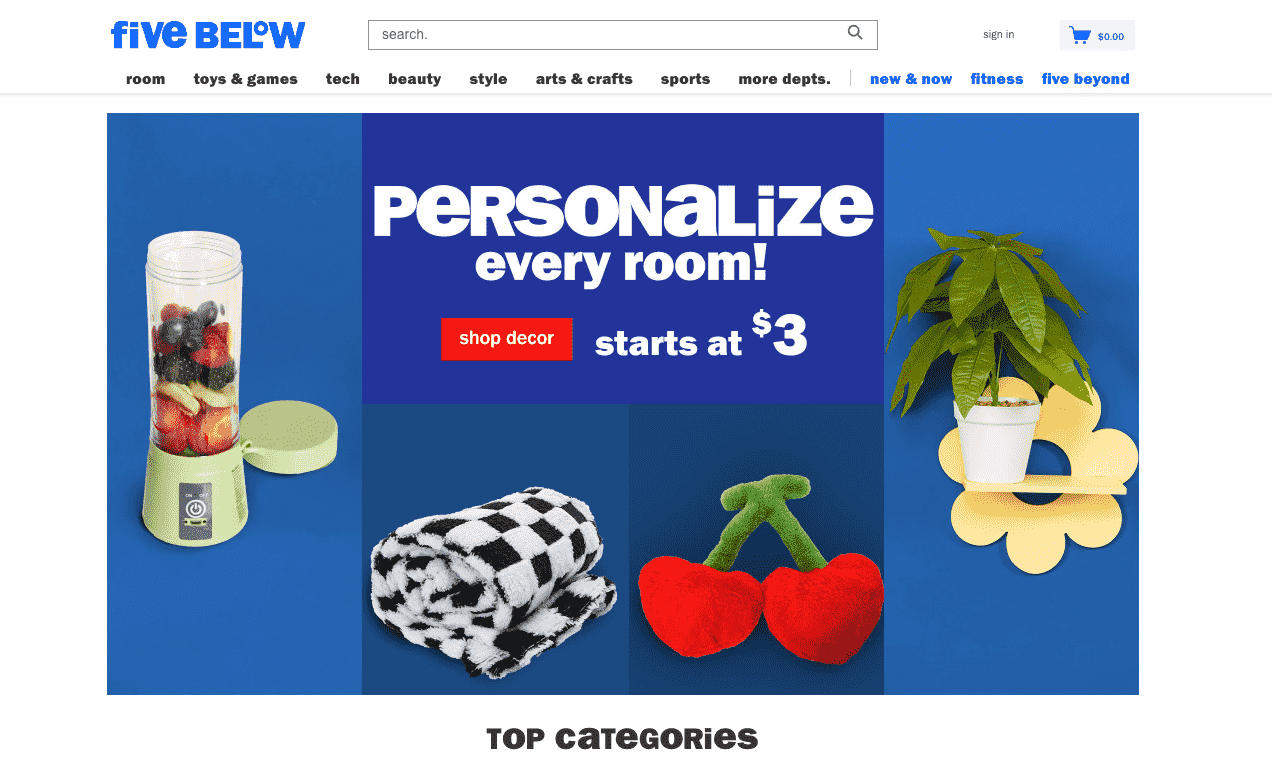
Five Below is a fun quick stop for affordable finds on a day out, but the website doesn’t offer the same experience when opting for an online shopping spree. The home page takes multiple seconds to load, and when it does stop buffering, portions of the site are revealed in chunks since various elements load at different speeds. Images over 100KB in size are likely to delay a page’s load time, and third-party plugins or pixels associated with a site are known to interfere with its loading ability.
Technology has evolved to the point of nearly instant gratification today, so impatient users don’t waste a lot of time waiting for content to load. They’ll move on to the next site or explore a competitor instead. The benefit of a website redesign for a slow-paced webpage is that new design elements can be optimized appropriately for faster load times and a convenient user experience.
2. Boring Layouts
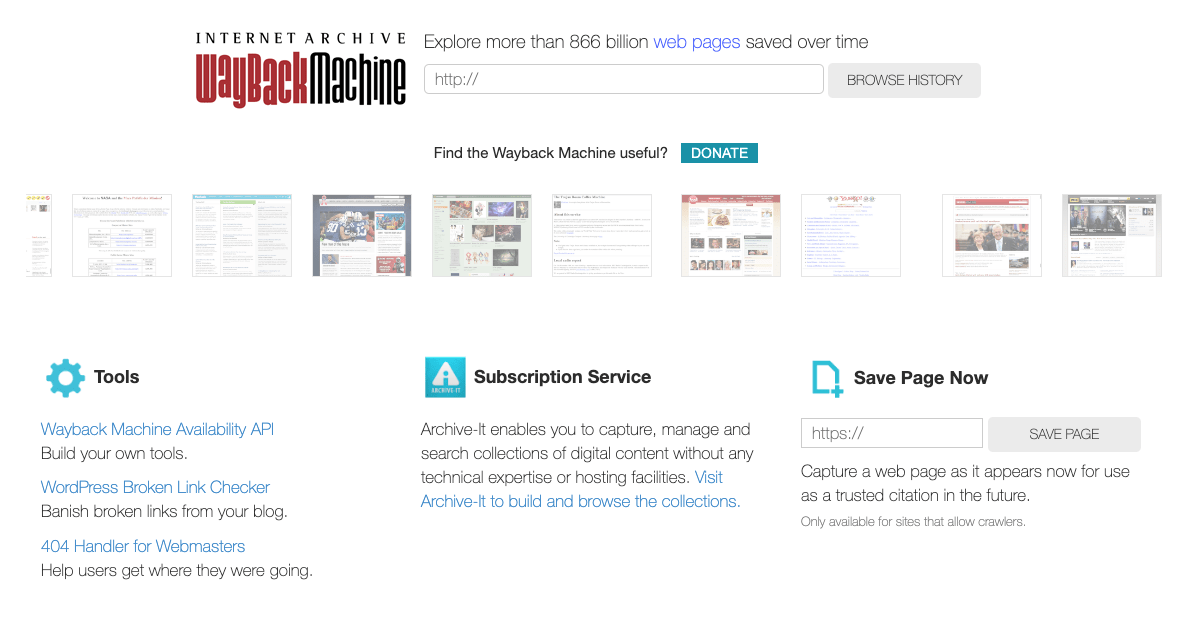
Minimalism is a sought-after web design trend for modern brands, but this clean design style is so popular because of its ability to create focal points and provide a simplified user experience. In the case of the Wayback Machine, there is no hierarchy or visual interest on the page to direct your eye. The whitespace isn’t purposeful; it’s just uninteresting.
In the Wayback Machine’s defense, it’s primarily used as a tool to explore archived websites from the past (and has seemingly taken inspiration from its time travels for its own web design). Brands trying to attract users and establish brand awareness and recognition don’t have such a luxury. Your website should provide visual interest and direct attention to focal points to keep users engaged with your site and coming back for more.
3. Cluttered Design Or Difficult Readability
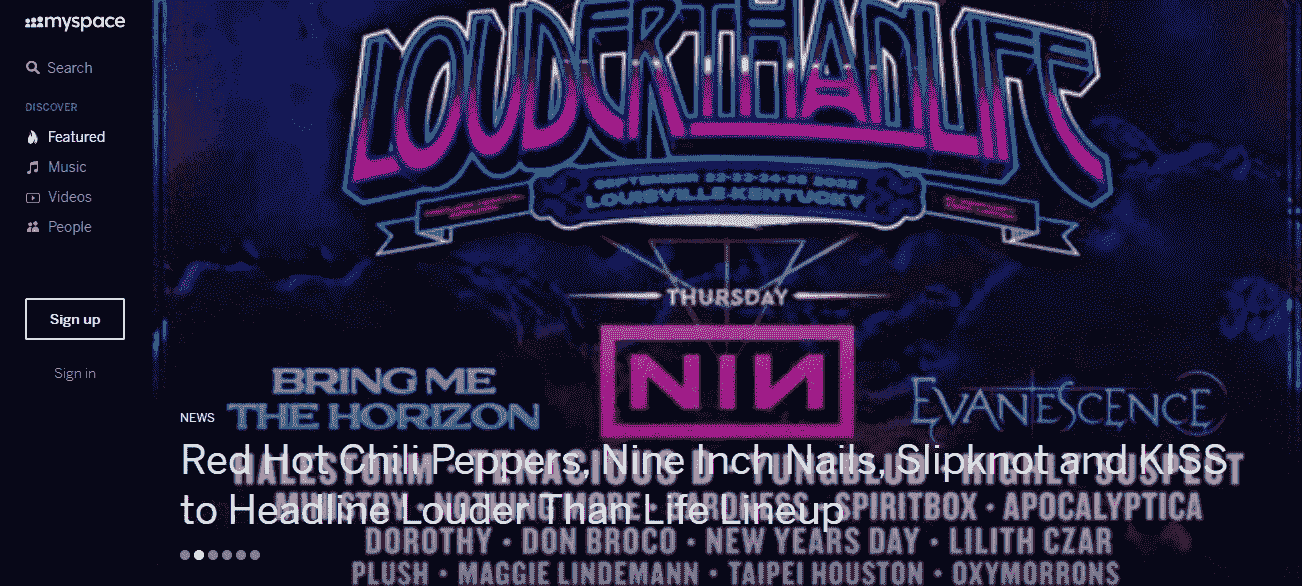
A blast from your mid-2000s past, Myspace does still have a web presence today, though it mainly caters to musicians and has more of a niche user base. The homepage features a rotating header image promoting various events and relevant news, but the accompanying text isn’t always legible against the distracting background.
It’s OK to have a niche following for your platform, but your site should still include key accessibility features like contrast so your content can be available to as many users as possible. Accessibility is a critical part of any web design and shouldn’t be overshadowed by design elements that make it difficult to digest and fully understand the page.
4. Missing A Clear Call To Action
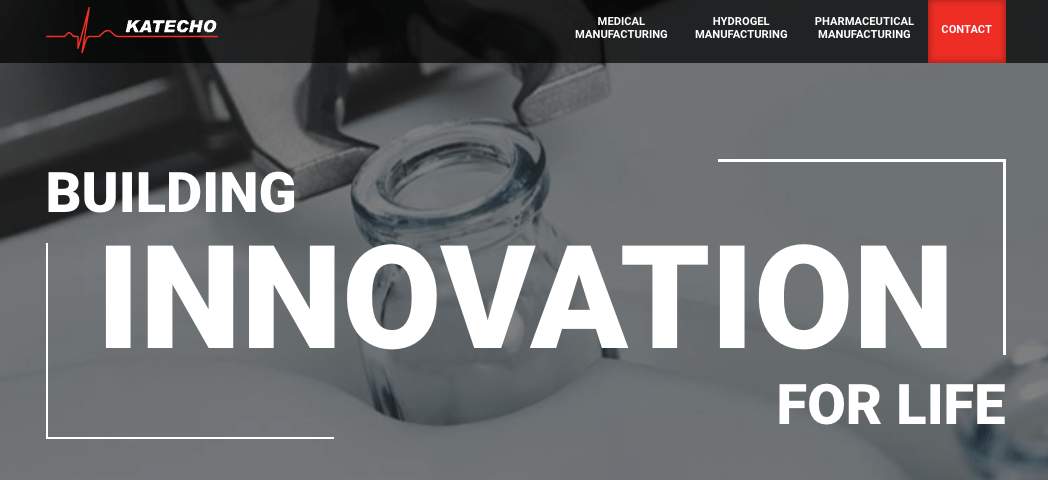
One of the most important elements of any website makeover is clickable call to actions integrated throughout the site at key conversion points. Without a nudge in the right direction, users aren’t likely to explore your site or your business offerings further.
See how Katecho’s prominent header image takes up all of the space above the fold. As a first-time user of their website, this header image and accompanying header don’t make it clear who Katecho is or what they do. There is also a missed opportunity to include a call-to-action button or other clickable visual element to draw users further throughout the site. There is nothing for the user to click if they want to learn more. A custom website redesign allows your business to utilize space on your site in a smarter way, with call-to-action buttons taking center stage.
5. Too Little Content
Berkshire Hathaway is one of the most recognizable investment companies across the globe, but you wouldn’t know it from looking at their website. One of the most common issues our experts at Blue Compass come across during our website redesign services is a lack of content throughout the site. Berkshire Hathaway primarily deals with numbers, so perhaps it’s no wonder they’re not good with words.
Along with being boring and serving as the poster child for outdated websites, the page comes across as disjointed and uninviting. It’s unclear who Berkshire Hathaway is, and the minimal content on the page doesn’t provide further context. To reap SEO benefits and become a truly valuable resource for users, webpages should have a minimum of 300 words, though we recommend at least 600 words to truly resonate with your readers.
If multiple pages on your business’ website have fewer than 200 words, it’s likely your site’s navigation is also cluttered and confusing. Websites that need a redesign typically also benefit from a new navigation structure, which may involve combining pages to minimize the number of clicks users need to take to access interior pages. The best way to build a relationship with potential customers is to answer their questions, not create more questions for them.
6. Design Isn’t Responsive Across Multiple Devices
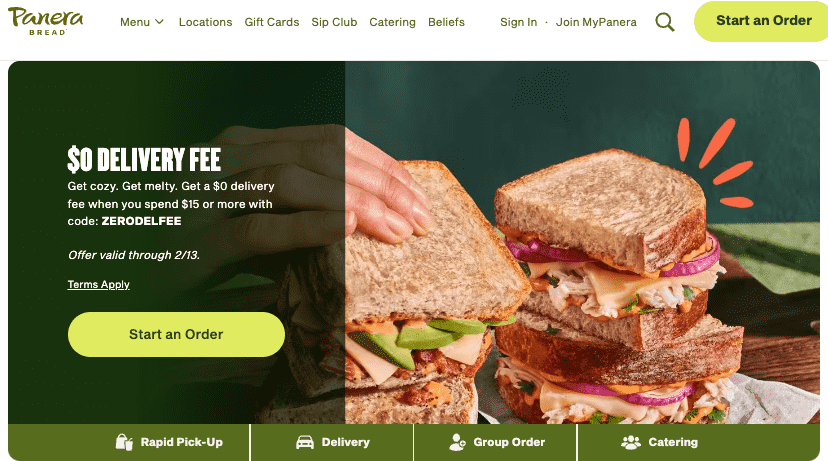
Most people have ordered takeout from a restaurant like Panera Bread more than once. Perhaps in one instance you received your sandwich order just the way you like, with the perfect ratio of meat and cheese to condiments and veggies. But the next time, a different worker goes heavy on the condiments and overpowers your now soggy sandwich. Inconsistencies like this can cause your perception of Panera Bread to shift because you don’t know what to expect.
The same principle applies to modern web design: if your website packs a powerful punch on desktop but turns into distorted images and illegible text on mobile screens, your brand loses some of the credibility you’ve worked so hard to establish. Panera Bread’s mobile website display uses filters over photos of their menu items so supporting text is visible on mobile devices. On a desktop device, however, the images are displayed in full color and take up the vast majority of the page. Though prominently featured, the photos are pixelated and fuzzy, indicating responsive design flaws from one device to another.
If images and copy can’t translate across multiple devices, you can potentially alienate one segment of your audience altogether while another portion may backtrack on their initial impression of your business based on a poor follow-up experience from another device. Today’s brands should aim to meet customers where they are. Whether it’s a mobile device or desktop computer, a responsive website makeover readies your site to appeal to multiple sources of traffic.
7. Non-Intuitive Navigation
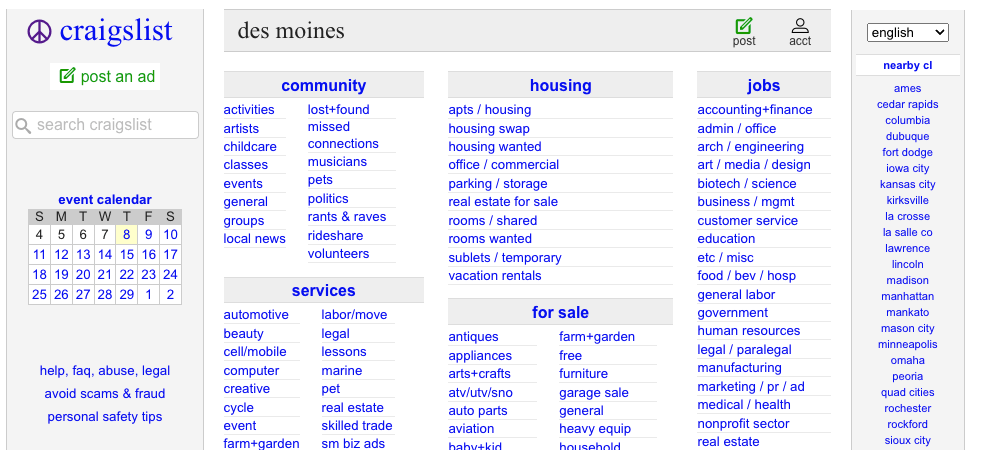
Craigslist is another mid-2000s throwback reminiscent of simpler times (you know, when you could invite an internet stranger to be your roommate without fearing for your life). However, there is nothing simple about the website’s navigation—or lack thereof. True to its name, the entire site is a list of links that’s overwhelming to view, with no hierarchy or visual elements to direct users throughout the site. Unless you’re Craig himself, you’re likely not finding what you need without investing your time to do some serious digging.
Website redesign services allow businesses to take a step back from their current site and evaluate what content exists and where it lives on the site. Maybe you find a surplus of content cluttering your navigation can be combined into one comprehensive resource. Or perhaps one of your most prominent pages is buried three levels deep in the navigation, preventing users from finding it and your business from gaining critical conversions. A website makeover from Blue Compass grants you the opportunity to work with professionals trained in the principles of user experience for a new-and-improved layout and simplified content hierarchy.
8. Dependance On Stock Imagery
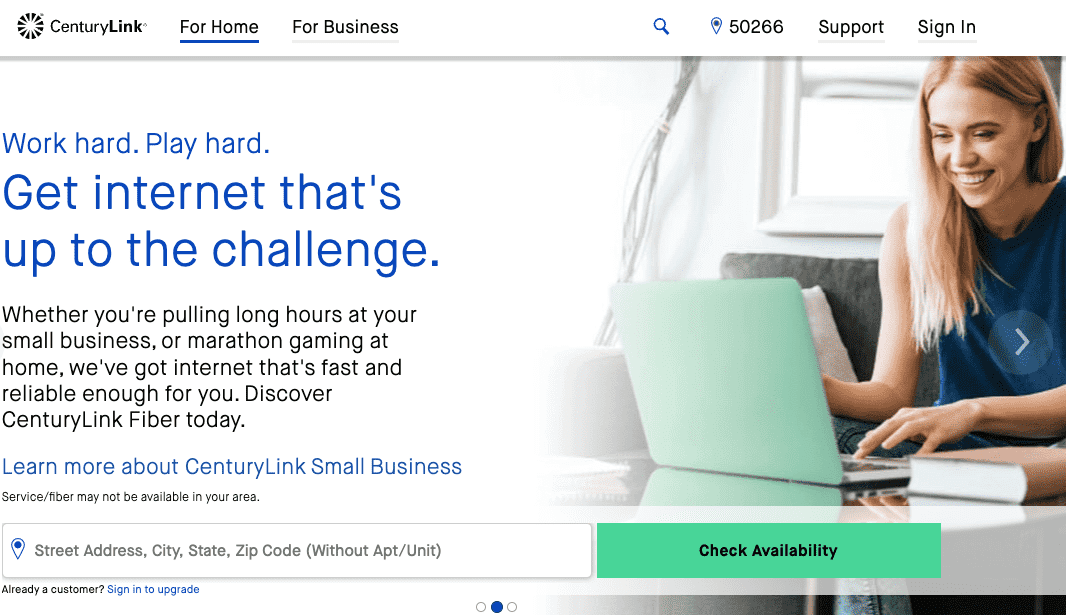
If you don’t have visual assets to support your web content, it’s tempting to turn to stock photos to add a personal touch to your business. But stock photos aren’t personal, and most people know these images are not a real representation of your brand. It’s OK to use stock images to support other visual elements or photos on your site, but users are ultimately looking for something authentic before placing their trust in your brand. Yes, CenturyLink provides internet connection as a service, but their impersonal website makes it difficult to connect with who they are as a service provider.
If you have a backlog of photos but haven’t had the time or ability to update your website, website redesign services can help showcase your images in a new design centered around unique assets from your business. If you’re lacking images but have the capacity to take new shots of your team in action, these efforts can coincide with a custom website redesign so you’re featuring fresh photos with your new look.
And if photos simply aren’t a great option for your business, consider hiring a web designer with illustration experience to create custom graphics and design elements to tell your brand story and stand out amongst the competition. Illustrations offer the authenticity stock photos fail to achieve because they are unique to your brand and truly representative of who you are.
Find Inspiration For Your Redesign
Benefits Of Website Redesign Services
Sure, a custom website redesign allows your business to display a new look online, but the benefits of a website redesign extend far beyond its appearance. Per HubSpot, an engaging new web design can increase the time spent on your site by 84%. A new design takes the user experience to the next level while also broadening the scope of your business’ search engine optimization (SEO) and marketing efforts. The longer users are on your site and the easier it is for them to find what they’re looking for, the more conversions you’ll get.
Generate More Traffic With Improved SEO
When a search engine is able to understand the value of your content, it’s much more likely to prioritize your content in search rankings compared to sites that aren’t optimized to showcase the same value. At Blue Compass, we provide SEO-first website redesign services, carefully approaching the technical aspects of your website to eliminate any potential errors or issues that could impact SEO potential. We pay attention not only to the details users will see but also to what Google and other search engines will see behind the scenes. A fresh look offers your business the opportunity to improve prominence in search rankings.
Present The Best Version Of Your Brand
Embracing a new web design allows you to keep up with the times, showing users you’re a modern, approachable brand able to connect with and anticipate their needs. By looking your best, you distinguish your brand from your competitors, create a more meaningful impression with your audience and carry through consistent branding to establish brand awareness.
Increase Sales & Conversions
Maybe you’ve noticed a low engagement rate on an important web page that’s buried deep within your site’s navigation. Or maybe your conversion points aren’t getting the attention you’d hoped to attract. Whatever your grievance is, it’s likely the users coming to your site have them, too. A website redesign is an opportune time to consider what’s working and what isn’t working within your site. The end goal is to create a new and improved website that brings your best assets front and center.
Think about what you want users to do on your site. How can you make those features more prominent to drive conversions and gain the traction you’re seeking? Making a website easier to navigate and more visually enticing to explore generates more sales and conversions than sticking with the status quo.
Simplify The User Experience
The benefits of a website redesign should resonate with your audience, too. What are their pain points when using your site? In the Information Age of technology at our fingertips, a site that’s difficult to use, slow to load or overwhelming to navigate will deter users from engaging with your content.
Custom website redesign services may include an overhaul of your site’s menu and navigation structure. Adjusting the flow of content and making it more available on your site helps users more easily locate the information they need to take action with your business. Creating a site hierarchy along with clear call-to-action buttons tells your users what’s important for them to focus on first while pointing them in the direction of what to do next, whether it’s contacting your business, accessing a related resource or making a purchase.
Enhance Site Security
Whether it’s identifying features like a home address or sensitive details like a credit card number, users input their personal data with the expectation of privacy. An outdated design is a red flag to many users, and often for good reason. Outdated websites weren’t built with the same security standards in place today, leaving your business exposed to cyber attacks and data breaches. To ensure user data—and your reputation—is safe, enlist the help of professional website redesign services to rebuild your site securely.
Manage Content With More Flexibility
If you have issues making updates to your site content now due to a tricky content management system (CMS), a new system can help streamline your efforts to add relevant content to your website and keep it updated with seasonal or news-worthy information. Blue Compass’ web developers can transition your site to a new CMS so it’s easier for your team to make updates. Once you gain the flexibility to replace outdated images and copy with new photos and content, you can prolong the life of your web design with new elements that bring a fun flair to your site.
Partner With Blue Compass For Your Custom Website Redesign
When you’re ready for an enduring website design able to keep up with the times and anticipate customer needs, our forward-thinking team of web designers and developers are here to help you create the website you and your users deserve. No matter what you hope to achieve with your website makeover, our website redesign services empower you to make a statement that your brand is here to stay. Reach out to schedule a 30 minute consultation to talk about your web design.
I’m Ready To Spruce Up My Web Design!